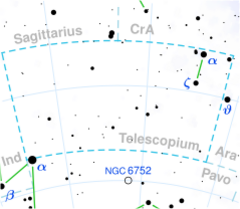Astronomy:Alpha Telescopii
| Observation data Equinox J2000.0]] (ICRS) | |
|---|---|
| Constellation | Telescopium |
| Right ascension | 18h 26m 58.41604s[1] |
| Declination | –45° 58′ 06.4498″[1] |
| Apparent magnitude (V) | 3.51[2] |
| Characteristics | |
| Spectral type | B3 IV[3] |
| U−B color index | −0.64[2] |
| B−V color index | −0.17[2] |
| Variable type | SPB[4] |
| Astrometry | |
| Radial velocity (Rv) | −0.2[5] km/s |
| Proper motion (μ) | RA: −16.95[1] mas/yr Dec.: −53.09[1] mas/yr |
| Parallax (π) | 11.74 ± 0.17[1] mas |
| Distance | 278 ± 4 ly (85 ± 1 pc) |
| Absolute magnitude (MV) | −1.25[6] |
| Details | |
| Mass | 5.2±0.4[4] M☉ |
| Radius | 3.3±0.5[4] R☉ |
| Luminosity | 794[4] L☉ |
| Surface gravity (log g) | 4.12±0.20[4] cgs |
| Temperature | 16,700±800[4] K |
| Rotational velocity (v sin i) | 14±8[4] km/s |
| Age | 24.1±7.5[7] Myr |
| Other designations | |
| Database references | |
| SIMBAD | data |
Alpha Telescopii, Latinized from α Telescopii, is the brightest star in the southern constellation of Telescopium, with an apparent visual magnitude of 3.5.[2] The ancient Roman astronomer Ptolemy included it in the constellation Corona Australis, but it was moved to Telescopium when that constellation was created by French astronomer Nicolas Louis de Lacaille in the 18th century.[9] Parallax measurements put it at a distance of 278 light-years (85 parsecs) from Earth. At that range, the visual magnitude of the star is diminished by an extinction of 0.22 due to interstellar dust.[6]
Properties
Physical Characteristics
This star is much larger than the Sun, with an estimated 5.2±0.4 times the mass and 3.3±0.5 times the radius.[4] The spectrum of the star matches a stellar classification of B3 IV,[3] where the luminosity class of 'IV' indicates this is a subgiant star that has nearly exhausted the supply of hydrogen at its core and is evolving away from the main sequence. Alpha Telescopii is a bright star that is radiating nearly 800 times the Sun's luminosity. This energy is being emitted from the star's outer envelope at an effective temperature of around 16,700 K,[4] giving it the characteristic blue-white hue of a B-type star.[10]
Variability
This is possibly a type of variable star known as a slowly pulsating B-type star. It has a longitudinal magnetic field with a mean strength of –233 ± 43 G.[4] A projected stellar rotation velocity of about 14 km s−1 is considered low for a star of this type,[4] which may indicate it is being viewed from nearly pole-on.[11]
References
- ↑ 1.0 1.1 1.2 1.3 1.4 van Leeuwen, F. (November 2007), "Validation of the new Hipparcos reduction", Astronomy and Astrophysics 474 (2): 653–664, doi:10.1051/0004-6361:20078357, Bibcode: 2007A&A...474..653V
- ↑ 2.0 2.1 2.2 2.3 Johnson, H. L. et al. (1966). "UBVRIJKL photometry of the bright stars". Communications of the Lunar and Planetary Laboratory 4 (99): 99. Bibcode: 1966CoLPL...4...99J.
- ↑ 3.0 3.1 Houk, Nancy (1978), Michigan catalogue of two-dimensional spectral types for the HD stars, 2, Ann Arbor: Dept. of Astronomy, University of Michigan, Bibcode: 1975mcts.book.....H
- ↑ 4.00 4.01 4.02 4.03 4.04 4.05 4.06 4.07 4.08 4.09 4.10 Hubrig, S. et al. (April 2009), "New magnetic field measurements of β Cephei stars and slowly pulsating B stars", Astronomische Nachrichten 330 (4): 317, doi:10.1002/asna.200811187, Bibcode: 2009AN....330..317H
- ↑ Evans, D. S. (June 20–24, 1966), "The Revision of the General Catalogue of Radial Velocities", in Batten, Alan Henry; Heard, John Frederick, Determination of Radial Velocities and their Applications, Proceedings from IAU Symposium no. 30, 30, University of Toronto: International Astronomical Union, p. 57, Bibcode: 1967IAUS...30...57E
- ↑ 6.0 6.1 Gontcharov, G. A. (November 2012), "Spatial distribution and kinematics of OB stars", Astronomy Letters 38 (11): 694–706, doi:10.1134/S1063773712110035, Bibcode: 2012AstL...38..694G.
- ↑ Tetzlaff, N.; Neuhäuser, R.; Hohle, M. M. (January 2011), "A catalogue of young runaway Hipparcos stars within 3 kpc from the Sun", Monthly Notices of the Royal Astronomical Society 410 (1): 190–200, doi:10.1111/j.1365-2966.2010.17434.x, Bibcode: 2011MNRAS.410..190T
- ↑ "alf Tel -- Star", SIMBAD (Centre de Données astronomiques de Strasbourg), http://simbad.u-strasbg.fr/simbad/sim-id?Ident=Alpha+Telescopii, retrieved 2012-01-15
- ↑ Ridpath, Ian, "Corona Austalis, the Southern Crown", Ian Ridpath's Star Tales, http://www.ianridpath.com/startales/coronaaustralis.htm, retrieved 2012-01-15
- ↑ "The Colour of Stars", Australia Telescope, Outreach and Education (Commonwealth Scientific and Industrial Research Organisation), December 21, 2004, archived from the original on March 18, 2012, https://web.archive.org/web/20120318151427/http://outreach.atnf.csiro.au/education/senior/astrophysics/photometry_colour.html, retrieved 2012-01-16
- ↑ Kaler, James B., "ALPHA TEL (Alpha Telescopii)", Stars (University of Illinois), http://stars.astro.illinois.edu/sow/alphatel.html, retrieved 2012-01-15
 |

